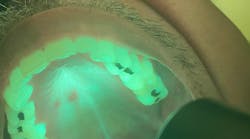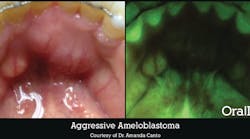Recent study links vaping to oral cancer, highlights dentists’ role in early detection
Since the mid-2000s, the incidence of oral cancer has been on the rise.1 A potential contributor could be the popularity of vaping, which has skyrocketed in the last few years, with e-cigarette sales increasing by 46.6% from January 2020 to December 2022.2
A recent study conducted by a team of researchers from the United Kingdom and Europe found that e-cigarette use, even for a limited time, can lead to DNA modifications identical to those seen in traditional smoking that can precipitate carcinogenesis.3
April is Oral Cancer Awareness Month, and in light of these findings, it’s important to recognize the critical role dentists play in early oral cancer detection and prevention.
The ins and outs of oral cancer
Oral cancer, like many other cancers, can be difficult to identify. Some patients may not have any early symptoms, whereas others may have lesions or sores on their mouths or lips, pain when swallowing, difficulty breathing, loose teeth, or persistent oral lumps.4
Tobacco use is a major risk factor for oral cancer, as is alcohol use, HPV infection, and sun exposure.5
In the case of tobacco use, vaping is just as harmful as traditional smoking. Like smoking, vaping has been shown to induce changes in DNA methylation that can lead to cancer.3 Both behaviors increase the risk of periodontal disease and oral cancer, which in turn can lead to reduced tooth stability, tooth extractions, and decay.6 Tobacco users may end up requiring full-mouth extractions and prosthetics, considering that much of the damage is irreversible. Additionally, procedures such as dental implants are less successful in smokers, which can limit treatment options.
Dentists and hygienists play a crucial role
Cancer is easier to treat if it is caught early. All patients should visit their dentists regularly for hygiene treatment and screenings; even those without the traditional risk factors for oral cancer. This is equally important for denture patients—many of whom only visit their dentist when they have an issue with the way their dentures are fitting or if they need a replacement.
As dental professionals, we are often the first defense against the progression of oral cancer, and we must take screenings very seriously. At many Aspen Dental practices, dental providers harness the power of fluorescence technology to identify early dysplastic changes that could otherwise be difficult to detect using traditional visual evaluation methods.
If we can catch oral cancers before they progress, we can save our patients’ mouths, and possibly their lives.
New technology makes screenings easier than ever
In addition to clinical and visual exams of the mouth, head, and neck areas, dentists now have access to powerful technology to make cancer screenings easier and more convenient.
When screening for oral cancer during a preventive visit, devices using fluorescence—often similar in appearance to small flashlights equipped with a special lens—illuminate the posterior oropharynx and help providers visualize mucosal abnormalities. These abnormal lesions, when illuminated with fluorescent light and observed through filtered lenses like caps or goggles, distinguish themselves differently from healthy tissue. Fluorescence technology also allows hygienists to see further into the back of the throat and further below the surface level of tissue. This is especially important, since as of 2019, the ADA requires oral cancer screenings to include the head and neck to better detect oropharyngeal cancer.7 This policy expansion is crucial given the rise in oral and oropharyngeal cancers over the past two decades.8
Let’s reduce oral cancer rates together
Both patients and doctors have roles to play in reducing oral cancer rates. Patients need to be aware of the oral-health risks associated with smoking and vaping, alcohol use, and sun exposure, as well as the importance of visiting their dentists regularly.
Dentists need to be diligent in providing oral cancer screenings and educating patients. Together, we can work to reduce the rise in oral cancer.
Editor's note: This article originally appeared in DE Weekend, the newsletter that will elevate your Sunday mornings with practical and innovative practice management and clinical content from experts across the field. Subscribe here.
References
- Oral cancer incidence (new cases) by age, race, and gender. National Institute of Dental and Craniofacial Research, US Department of Health and Human Services. Last reviewed April 2023. www.nidcr.nih.gov/research/data-statistics/oral-cancer/incidence
- US e-cigarette sales climbed during 2020–2022. CDC Newsroom. June 22, 2023. www.cdc.gov/media/releases/2023/p0622-ecigarettes-sales.html
- Herzog C, Jones A, Evans I, et al. Cigarette smoking and e-cigarette use induce shared DNA methylation changes linked to carcinogenesis. Cancer Res. Published online March 19, 2024. doi:10.1158/0008-5472.CAN-23-2957
- Oral cancer. National Institute of Dental and Craniofacial Research, US Department of Health and Human Services. Last reviewed June 2023. www.nidcr.nih.gov/health-info/oral-cancer
- Risk factors for oral cavity and oropharyngeal cancers. American Cancer Society. Updated March 23, 2021. Accessed March 31, 2024. www.cancer.org/cancer/types/oral-cavity-and-oropharyngeal-cancer/causes-risks-prevention/risk-factors.html
- Periodontal disease. Centers for Disease Control and Prevention. Last reviewed July 10, 2013. www.cdc.gov/oralhealth/conditions/periodontal-disease.html
- Glass S, Brown V, Carrico C, Madurantakam P. Head and neck exam practices of dental professionals. Clin Exp Dent Res. 2023;9(5):887-893. doi:10.1002/cre2.772
- Key statistics for oral cavity and oropharyngeal cancers. American Cancer Society. Updated January 19, 2024. www.cancer.org/cancer/types/oral-cavity-and-oropharyngeal-cancer/about/key-statistics.html
Arwinder Judge, DDS, chief clinical officer for Aspen Dental, is responsible for developing, implementing, and leading programs that support the dentists who own and operate Aspen Dental-branded practices.
About the Author
Arwinder Judge, DDS, chief clinical officer for Aspen Dental
Arwinder Judge, DDS, chief clinical officer for Aspen Dental, is responsible for developing, implementing, and leading programs that support the dentists who own and operate Aspen Dental-branded practices.


